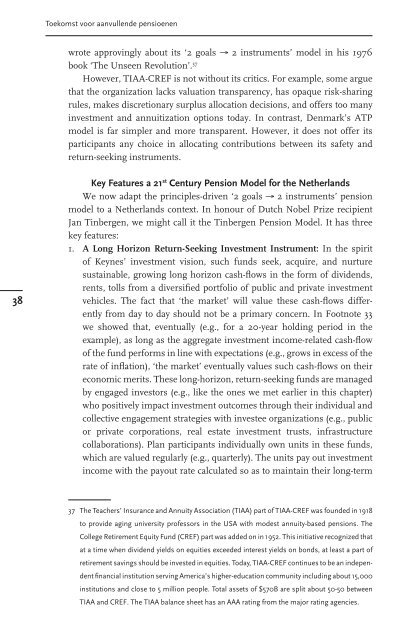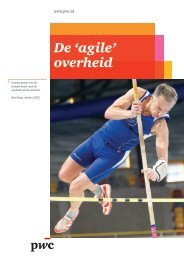Toekomst voor aanvullende pensioenen
Toekomst voor aanvullende pensioenen
Toekomst voor aanvullende pensioenen
- No tags were found...
You also want an ePaper? Increase the reach of your titles
YUMPU automatically turns print PDFs into web optimized ePapers that Google loves.
<strong>Toekomst</strong> <strong>voor</strong> <strong>aanvullende</strong> <strong>pensioenen</strong>wrote approvingly about its ‘2 goals 2 instruments’ model in his 1976book ‘The Unseen Revolution’. 37However, TIAA-CREF is not without its critics. For example, some arguethat the organization lacks valuation transparency, has opaque risk-sharingrules, makes discretionary surplus allocation decisions, and offers too manyinvestment and annuitization options today. In contrast, Denmark’s ATPmodel is far simpler and more transparent. However, it does not offer itsparticipants any choice in allocating contributions between its safety andreturn-seeking instruments.38Key Features a 21 st Century Pension Model for the NetherlandsWe now adapt the principles-driven ‘2 goals 2 instruments’ pensionmodel to a Netherlands context. In honour of Dutch Nobel Prize recipientJan Tinbergen, we might call it the Tinbergen Pension Model. It has threekey features:1. A Long Horizon Return-Seeking Investment Instrument: In the spiritof Keynes’ investment vision, such funds seek, acquire, and nurturesustainable, growing long horizon cash-flows in the form of dividends,rents, tolls from a diversified portfolio of public and private investmentvehicles. The fact that ‘the market’ will value these cash-flows differentlyfrom day to day should not be a primary concern. In Footnote 33we showed that, eventually (e.g., for a 20-year holding period in theexample), as long as the aggregate investment income-related cash-flowof the fund performs in line with expectations (e.g., grows in excess of therate of inflation), ‘the market’ eventually values such cash-flows on theireconomic merits. These long-horizon, return-seeking funds are managedby engaged investors (e.g., like the ones we met earlier in this chapter)who positively impact investment outcomes through their individual andcollective engagement strategies with investee organizations (e.g., publicor private corporations, real estate investment trusts, infrastructurecollaborations). Plan participants individually own units in these funds,which are valued regularly (e.g., quarterly). The units pay out investmentincome with the payout rate calculated so as to maintain their long-term37 The Teachers’ Insurance and Annuity Association (TIAA) part of TIAA-CREF was founded in 1918to provide aging university professors in the USA with modest annuity-based pensions. TheCollege Retirement Equity Fund (CREF) part was added on in 1952. This initiative recognized thatat a time when dividend yields on equities exceeded interest yields on bonds, at least a part ofretirement savings should be invested in equities. Today, TIAA-CREF continues to be an independentfinancial institution serving America’s higher-education community including about 15,000institutions and close to 5 million people. Total assets of $570B are split about 50-50 betweenTIAA and CREF. The TIAA balance sheet has an AAA rating from the major rating agencies.




![Proefschrift Hanneke A. Luth[lr]](https://img.yumpu.com/51055008/1/178x260/proefschrift-hanneke-a-luthlr.jpg?quality=85)

![Proefschrift Hanneke A. Luth[lr]](https://img.yumpu.com/24018368/1/178x260/proefschrift-hanneke-a-luthlr.jpg?quality=85)